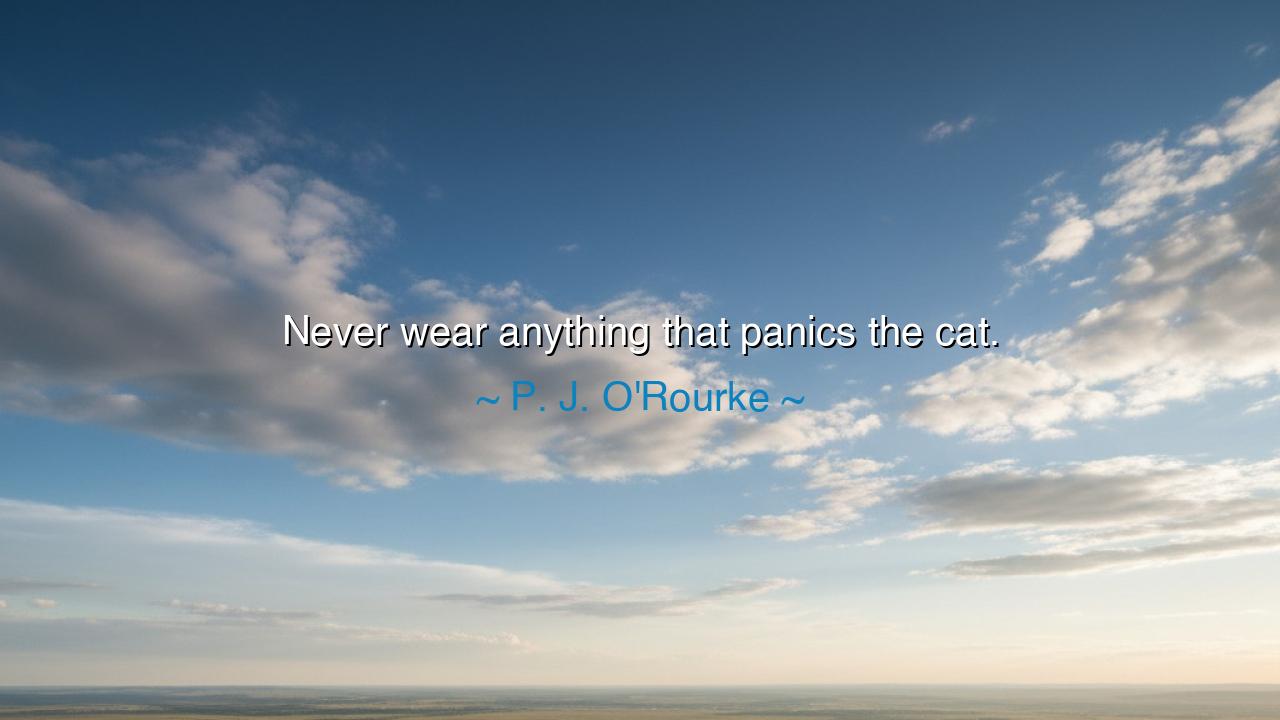
Never wear anything that panics the cat.






P. J. O’Rourke, with wit sharpened by humor yet wrapped in hidden wisdom, once declared: “Never wear anything that panics the cat.” At first, these words may sound like mere jest, a playful instruction about garments and pets. Yet beneath their laughter lies a deeper parable. The cat, subtle and watchful, is a symbol of nature’s delicate balance, of the world’s quiet order that is so easily disturbed by human folly. To panic the cat is to disturb harmony, to draw too much noise, too much spectacle, too much vanity into life. Thus O’Rourke counsels us, in his jest, to live with moderation, humility, and respect for the natural rhythms around us.
The cat is the judge of stillness and subtlety. Its eyes, wide and unblinking, pierce through pretension. It recoils from chaos, yet it draws near to calm. When O’Rourke warns us not to wear what frightens the cat, he is in truth warning against excess, arrogance, and flamboyance that disrupt the peace of the household and the spirit alike. Clothing here becomes a symbol for all our outward expressions—the way we present ourselves, the choices we make, the energy we carry. If it panics the cat, it likely panics the harmony of life itself.
Consider history’s great cautionary tales. In the court of Marie Antoinette, nobles adorned themselves with towering wigs and absurd costumes, each outfit more ostentatious than the last. While the cats of Versailles may or may not have been panicked, the people certainly were. The gulf between the noble’s extravagance and the peasant’s hunger grew so wide that revolution was born. Here, O’Rourke’s playful proverb finds deadly truth: to live in such a way that even the simplest, quietest eyes recoil is to invite downfall. Excess leads to unrest, whether in the heart of a cat or in the heart of a nation.
And yet, the opposite lesson also shines through. Gandhi, clothed in the simplest homespun cloth, never panicked the cat. His garments carried humility, peace, and truth. His very presence calmed, rather than disturbed. In rejecting grandeur, he embodied strength; in wearing simplicity, he adorned himself with dignity greater than kings. This is the balance O’Rourke points toward: the wisdom to wear not what dazzles, but what harmonizes; not what shouts, but what whispers strength.
But the proverb does not end with clothing alone. To “never wear anything that panics the cat” is also to guard against adopting attitudes, habits, or displays that unsettle the quiet souls around us. It is a teaching about consideration, about living in a way that others—whether animals, companions, or strangers—feel safe in our presence. To wear wrath, to wear envy, to wear arrogance—these too are garments that panic the cat of life. And such garments must be cast aside.
The lesson, then, is clear: seek harmony in how you live, in how you present yourself, in what you choose to display to the world. Let your appearance and your actions be clothed in humility and grace. Ask yourself: does this choice bring peace, or does it disturb it? Does it calm the cat, or does it send it fleeing in fear? For the cat, in truth, is the mirror of life’s quiet balance, and to panic it is to lose touch with the gentler currents of existence.
Practically, we may live this wisdom by embracing simplicity—clothing that serves rather than shouts, words that soothe rather than wound, actions that build rather than break. Pause before excess; choose grace over spectacle. Let moderation be your adornment, and peace your garment. In this way, you will carry yourself as one who disturbs neither beast nor brother, but who moves with calm authority through the world.
So hear O’Rourke’s jest as more than laughter: “Never wear anything that panics the cat.” For within it lies the call to live gently, to honor the balance of life, to move through the world not as a storm that scatters, but as a presence that comforts. Live so that even the watchful eyes of the cat, guardian of subtle truth, find no reason to fear, but every reason to stay by your side.






AAdministratorAdministrator
Welcome, honored guests. Please leave a comment, we will respond soon